#131: The History of The Gadsden Flag, Spain in the American Revolution, and the Charleston Tea Garden Trolley Tour
For South Carolina history lovers far and wide! Published weekly on Monday mornings. Enjoy weekly SC history articles, interviews w/ experts, book recommendations, and upcoming SC historical events.
Dear readers,
Welcome to SC History Newsletter #130!
I want to thank those of you who wrote such kind notes to me after last week’s newsletter. It made my week! A few of you also sent me interesting ideas for future newsletters, which I will definitely add to my list. A reminder you can always hit “reply” to this email and send me your ideas :)
I’d like to welcome the following new subscribers!
randycannon
bnnemory94
ebmurphy4077
paveit999
stafford652
sled253
stacyemory
dailm98
lisawpope
smoakandrives
kowens
Deana.Broach
dshelley
preston
apirby1
Thank you so much, as always for supporting the newsletter — it truly means so much.
And now, let’s learn some South Carolina history!
Yours truly,
Kate
(Writing from Greenville, SC)
➳ Housekeeping for new subscribers!
New friends! If you are new to the newsletter, please note that there are over 100 previous SC History newsletters on topics ranging from the founding of Charleston, sunken Confederate submarines, railroad tunnels filled with blue cheese, and so much more! I encourage you to take a look at our archive here. And here are a few top posts to start you off:
#107: Surviving Hurricane Hugo, a Textile Tour, and the Combahee River Raid
#122: General Nathanael Greene, Revolutionary War "Lunch & Learn," and The Demon of Unrest
Send me your comments or topic ideas: I love it when subscribers write to me! Have a SC History topic or question you’d like for me to write about? Have additional ideas or feedback for me? Just reply to this email and let me know!
Join us on social: Please join us & keep the conversation going by becoming a member of our SC History Newsletter Facebook Community here! I can’t wait to meet you. :)
If your email “cuts off”: In your email app or website, if my emails “cut off” for you, please click the title of the email and it will take you to the full post on the Substack. I don’t want you to miss any content!
As of today February 3, 2025, we are at 868 subscribers. Help us get to 1,000 subscribers! Share the SC History Newsletter with a fellow history lover! :)
➳ Featured SC History Events
Please note our featured SC History Event below, and as a perk for paid subscribers, click here or the button below to visit my full SC History Events Calendar that organizes all the upcoming SC history events I have discovered.
Please let me know if you’d like to add an event to the calendar! Reply to this email to send me your events.
Event Highlight of the Week:
Thank you to our subscriber Penny S. for submitting the event below:
Tuesday, February 4th at 6:00 pm | “Spain’s Contribution to the American Revolution - Lecture by Dr. Harold Thomas Gonzales Jr.” | Temple Sinai | Sumter, SC | FREE
➳ Other SC History Recommendations
The Charleston Tea Garden Trolley Tour
Note from Kate: I wrote SC History Newsletter #51 about the history of Charleston Tea Garden, where the first-ever American-grown tea was made! While researching, I learned about their magical Trolley Tour (pictured above), and have longed to go on it! Have any of y’all ever done the tour? Wanted to highlight it below as a possible amazing destination for our future South Carolina history adventures :)
From the Charleston Tea Garden website:
“Cruise through lush landscapes and endless rows of tea bushes on a 35-40 minute trolley ride. Immerse yourself in the world of tea as our charismatic guide shares fascinating tales during the tour. Our visionary founder, Bill Hall's voice narrates through the bus sound system, adds a touch of magic to your scenic voyage.
But the adventure doesn't stop there! The trolley makes a captivating stop at the greenhouse, where you'll disembark and witness the miracle of new tea bushes coming to life. It's a rare opportunity to get up close and personal with the birth of tea.
This Trolley Tour is more than a ride; it's a once-in-a-lifetime experience that will leave you in awe. Seize the moment—don't let this extraordinary journey pass you by!”
Have you ever done the Charleston Tea Garden Trolley Tour? We want to hear your stories! Leave a comment below!
➳ SC History Topic of the Week: The History of The Gadsden Flag
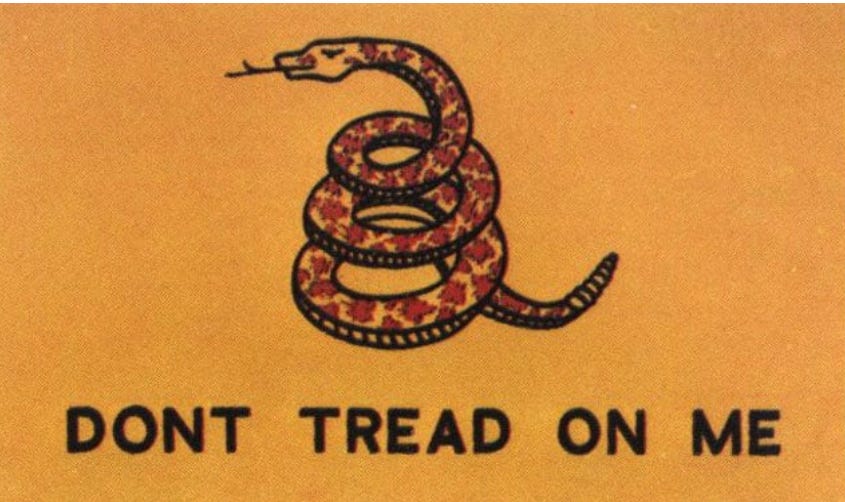
The Gadsden Flag was one of the first symbols of American Independence and was originally used by the Continental Navy in the American Revolution. It was designed by a man named Christopher Gadsden, who was a South Carolina merchant and outspoken politician against British rule.
Gadsden was born in Charleston in 1724 to a wealthy family. He studied at the best schools in England, then went on to a 4-year apprenticeship in Philadelphia. Between 1745-1747, served as a purser on the British man-of-war ship The Aldborough. A purser is the officer responsible for keeping accounts of the ship’s finances, passenger records, and overall administration.
By 1741, both of Gadsden’s parents had died, and he was left with a sizable inheritance, which he invested into his business endeavors. Gadsden owned four stores, several merchant vessels, two rice plantations, a residential district in Charleston called Gadsdenboro, and a large wharf on the Cooper River. According to the National Park Service, “Gadsden started one of the most profitable mercantile careers in the Carolinas.”
Christopher Gadsden’s mercantile business dealt in the import-export trade, which assisted South Carolina planters with shipping “their rice, indigo, and other commodities to markets abroad.”
And there was another element to Gadsden’s mercantile business…
As I was researching today’s topic, when I read that Gadsden owned a “large wharf in Charleston” I immediately connected this to our topic last week SC History Newsletter #130: The History of Charleston Harbor where large numbers of slaves were brought into the colonies (and then the United States) through … Gadsden’s Wharf!
At the time, Gadsden’s Wharf was located between Calhoun and Laurens Streets and was the largest wharf in North America at 840 feet in river frontage. It had taken 8 long years to build, and it was completed just a few months before the American Revolution began.1
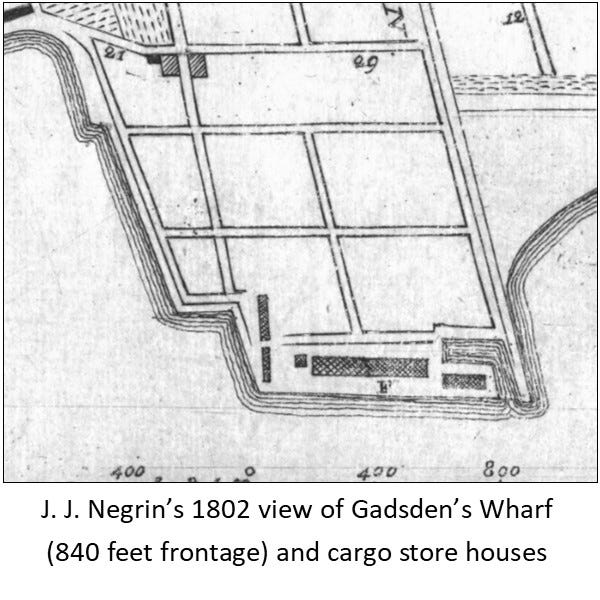
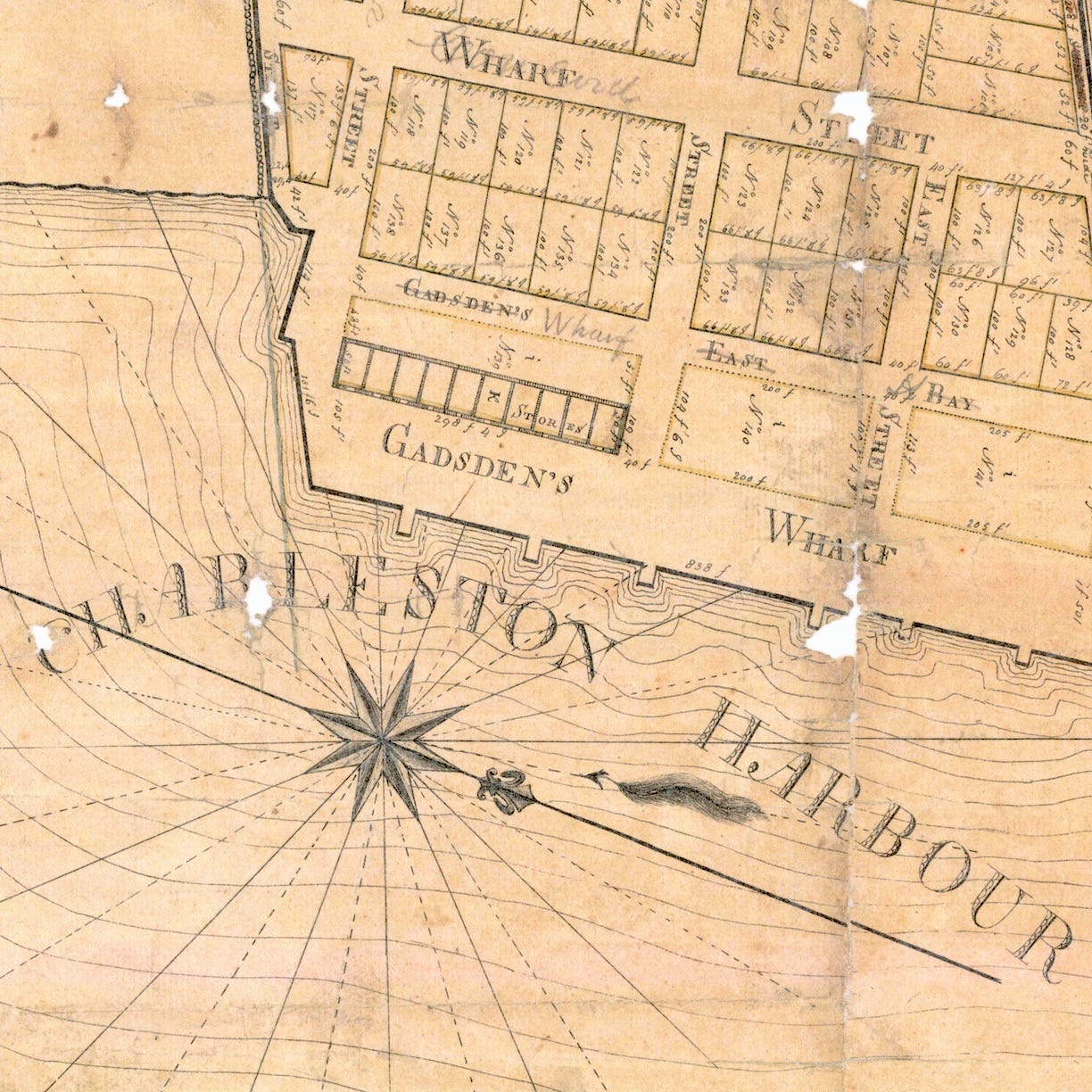
Today, Gadsden’s Wharf is now the site of the Liberty Square Education Center, a ferry departure location for Fort Sumter, and the new International African American Museum (IAAM) of Charleston, which opened in 2023.
IAAM Director Michael Moore said, “We’re creating our African-American museum on the spot where most of that history began…it’s a profoundly important, if not sacred, site that just accentuates what we’re doing.”2

Going back in time to 1774, Christopher Gadsden was at the height of his career as a merchant. He had disposable income and a desire to serve the South Carolina colony. He was ready to start a new career in public service.
Thus began nearly 3 decades of Gadsden’s service in the South Carolina Commons House of Assembly, where he was “a vocal defender of American rights.” At the Stamp Act Congress in New York in 1765, he pushed for “American home rule” and pushed back on “Parliamentary Supremacy.”
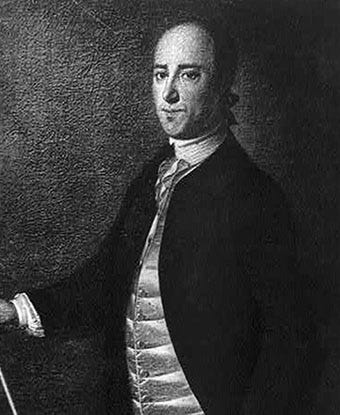
South Carolina historian Nic Bulter writes:
“Christopher Gadsden was in 1766 a successful middle-aged merchant aspiring to become a planter and ascend the social ladder. Having represented South Carolina in the New York Stamp-Act Congress of 1765 and having protested loudly against the stamps in Charleston in the spring of 1766, Gadsden demonstrated an uncommon vigor for asserting the rights and liberties of American colonists.”
Gadsden’s efforts to defend American rights came to the attention of Charleston’s Sons of Liberty, who invited Gadsden to meet with them in the autumn of 1776 — under the branches of an ancient live oak tree “just outside of urban Charleston.” In fact, Gadsden’s home was apparently “only 900 feet” away from this majestic tree, which would become known as the Liberty Tree. 26 men gathered that night with Gadsden.
The Sons of Liberty were mostly skilled tradesmen (referred to as “mechanics”) such as “blacksmiths, carpenters, wheelwrights, coopers, tailors, shipwrights, and so on, who made their living by laboring with their hands and tools.”3
One of the patriots there that evening was George Flagg (1741-1824), who, 50 years later, recalled the events of that fateful evening:
“On this occasion the above persons invited Mr. Gadsden to join them, and to meet at an oak tree just beyond Gadsden’s Green [Ansonborough], over the Creek at Hampstead, to a collation prepared at their joint expense for the occasion. Here they talked over the mischiefs which the Stamp Act would have induced, and congratulated each other on its repeal. On this occasion Mr. Gadsden delivered to them an address, stating their rights, and encouraging them to defend them against all foreign taxation. Upon which joining hands around the tree, they associated themselves as defenders and supporters of American Liberty, and from that time the oak was called Liberty Tree—and public meetings were occasionally holden [sic] there.”
This was an important moment in South Carolina Revolutionary War history where the Sons of Liberty looked to Christopher Gadsden as an ally who could help bridge the gap between the Lowcountry’s wealthy elite and working-class men (like the Sons of Liberty) for the cause of American Independence.
Historian Nic Butler further explains in his article “Remembering Charleston’s Liberty Tree, Part 1”: “This improvised act of political unity, recalled by an aged participant [George Flagg] more than fifty years after the fact, represents the genesis of the cooperative spirit that eroded class barriers and fueled the future success of the American Revolution in South Carolina.”4
Gadsden carried the torch of the Sons of Liberty and his voice grew even louder in local politics as his “extremism”5 led to proposals to “reject all Parliamentary legislation since 1763, to attack the Royal Navy in American waters, and to instruct each colony to prepare for war.”
In their article on Christopher Gadsden’s life, NPS.gov proposes the illuminating parallel that Gadsden, a “firebrand Patriot,” may well have been South Carolina’s equivalent to Samuel Adams in Boston.
As the colonies headed towards war, in 1775, General George Washington established the Continental Navy. Commodore Esek Hopkins was appointed commander-in-chief of the Navy.
In February of 1776, Christopher Gadsden became a colonel in the First Regiment and was also a member of the Provincial Congress.
At the time, the first “official flag” of the 13 colonies was known as “the Continental Colors” or the “Grand Union Flag” and consisted of 13 red and white stripes and the United Kingdom’s flag in the upper left-hand corner.

While “The Continental Colors” was the official flag, Christopher Gadsden decided to design another flag in support of American Independence.
On February 9, 1776, (then) Colonel Gadsden presented the South Carolina Provincial Congress with a yellow flag, on which was emblazoned a rattlesnake and the phrase “Don’t Tread On Me.”
Gadsden's presentation of the rattlesnake flag was recorded in the South Carolina congressional journals on February 9, 1776:
“Col. Gadsden presented to the [Provincial] Congress an elegant standard, such as is to be used by the commander in chief of the American Navy; being a yellow field, with a lively representation of a rattlesnake in the middle in the attitude of going to strike and these words underneath, "Don't tread on me."
(Note from Kate: In my research, I was unable to uncover if Gadsden had sketched the flag himself or worked with an artist. I also wonder who helped him physically stitch the flag together. Could it have been his wife?)
The Gadsden Flag would serve as the standard for Commodore Esek Hopkins naval ship. It would eventually be displayed “at the ship’s mainmast.”
Why did Gadsden choose a snake to represent the American colonies? The rattlesnake had already been a popular symbol of the American colonies for over 20 years.
The Timber Rattlesnake was a “large, thick-bodied, venomous” snake that was found throughout the original 13 American colonies and is naturally found only in eastern North America.6
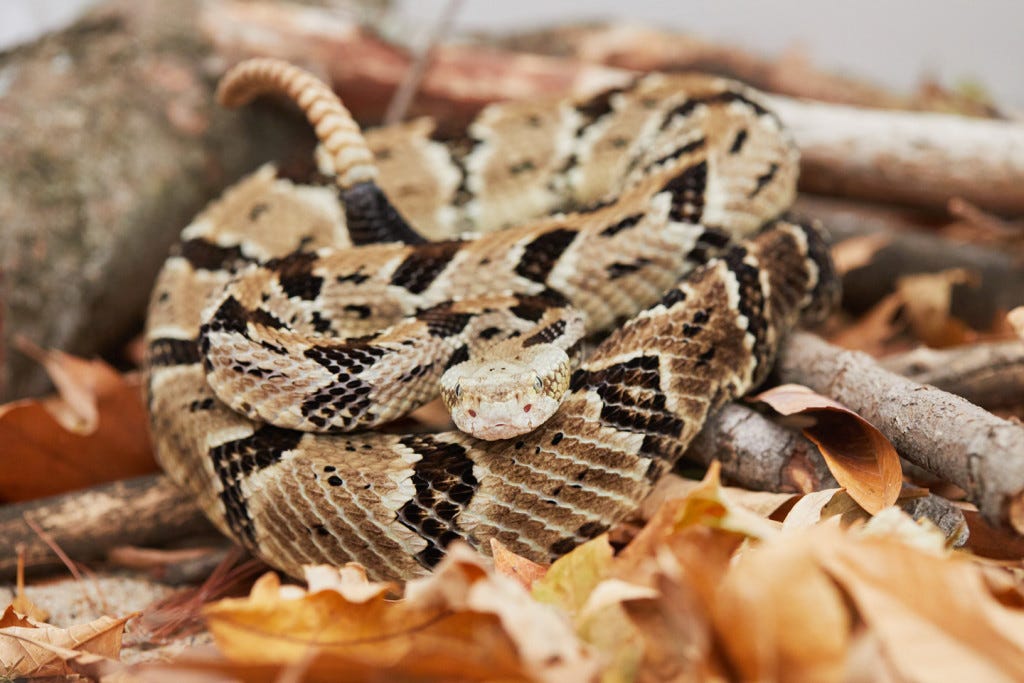
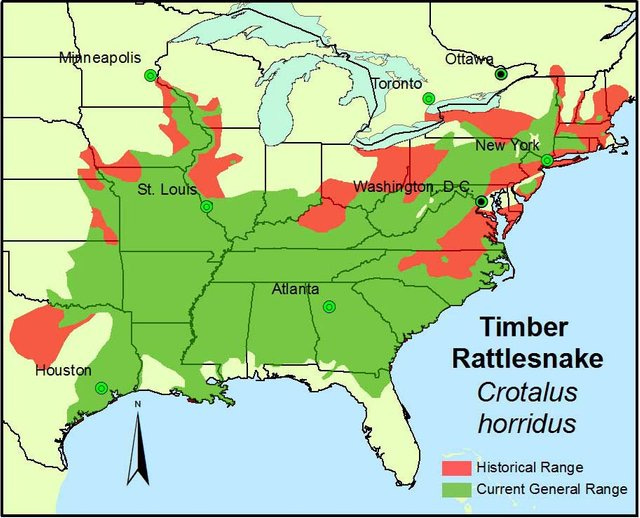
In 1754, it was Benjamin Franklin who created the “first viral image in American history,” which he published in his Pennsylvania Gazette. In an iconic image I’m sure we all remember from American History class (below), Franklin produced a cartoon of the American colonies in the form of a rattlesnake, with New England at the head and South Carolina at the tail, and the message “Join, Or Die” at the bottom. It was a call to arms against the British in not one, but two wars — first in the French & Indian War (1754-1763), and then in the American Revolution (1775-1783).
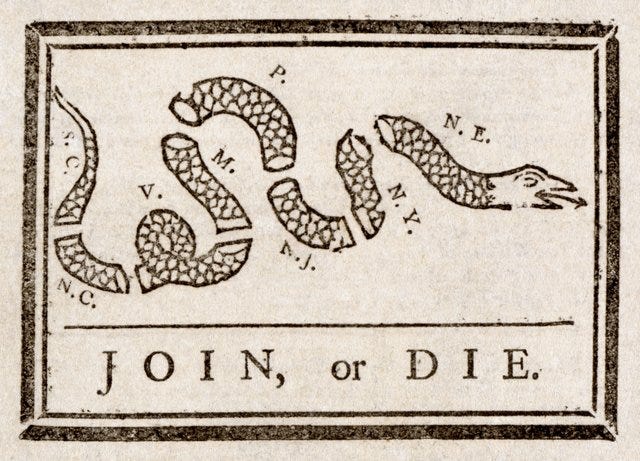
It was also Benjamin Franklin who, in December 27, 1775, in an anonymous letter from “An American Guesser” (later attributed to Franklin) for the Pennsylvania Journal, describes the ways in which the rattlesnake seems an appropriate symbol for America:
“I observed on one of the drums belonging to the marines now raising, there was painted a Rattle-Snake, with this modest motto under it, "Don't tread on me." As I know it is the custom to have some device on the arms of every country, I supposed this may have been intended for the arms of America; and as I have nothing to do with public affairs, and as my time is perfectly my own, in order to divert an idle hour, I sat down to guess what could have been intended by this uncommon device – I took care, however, to consult on this occasion a person who is acquainted with heraldry, from whom I learned, that it is a rule among the learned of that science "That the worthy properties of the animal, in the crest-born, shall be considered," and, "That the base ones cannot have been intended;" he likewise informed me that the ancients considered the serpent as an emblem of wisdom, and in a certain attitude of endless duration – both which circumstances I suppose may have been had in view. Having gained this intelligence, and recollecting that countries are sometimes represented by animals peculiar to them, it occurred to me that the Rattle-Snake is found in no other quarter of the world besides America, and may therefore have been chosen, on that account, to represent her.
But then "the worldly properties" of a Snake I judged would be hard to point out. This rather raised than suppressed my curiosity, and having frequently seen the Rattle-Snake, I ran over in my mind every property by which she was distinguished, not only from other animals, but from those of the same genus or class of animals, endeavoring to fix some meaning to each, not wholly inconsistent with common sense.
I recollected that her eye excelled in brightness, that of any other animal, and that she has no eye-lids. She may therefore be esteemed an emblem of vigilance. She never begins an attack, nor, when once engaged, ever surrenders: She is therefore an emblem of magnanimity and true courage. As if anxious to prevent all pretensions of quarreling with her, the weapons with which nature has furnished her, she conceals in the roof of her mouth, so that, to those who are unacquainted with her, she appears to be a most defenseless animal; and even when those weapons are shown and extended for her defense, they appear weak and contemptible; but their wounds however small, are decisive and fatal. Conscious of this, she never wounds 'till she has generously given notice, even to her enemy, and cautioned him against the danger of treading on her.
Was I wrong, Sir, in thinking this a strong picture of the temper and conduct of America? The poison of her teeth is the necessary means of digesting her food, and at the same time is certain destruction to her enemies. This may be understood to intimate that those things which are destructive to our enemies, may be to us not only harmless, but absolutely necessary to our existence. I confess I was wholly at a loss what to make of the rattles, 'till I went back and counted them and found them just thirteen, exactly the number of the Colonies united in America; and I recollected too that this was the only part of the Snake which increased in numbers. Perhaps it might be only fancy, but, I conceited the painter had shown a half formed additional rattle, which, I suppose, may have been intended to represent the province of Canada.
'Tis curious and amazing to observe how distinct and independent of each other the rattles of this animal are, and yet how firmly they are united together, so as never to be separated but by breaking them to pieces. One of those rattles singly, is incapable of producing sound, but the ringing of thirteen together, is sufficient to alarm the boldest man living.
The Rattle-Snake is solitary, and associates with her kind only when it is necessary for their preservation. In winter, the warmth of a number together will preserve their lives, while singly, they would probably perish. The power of fascination attributed to her, by a generous construction, may be understood to mean, that those who consider the liberty and blessings which America affords, and once come over to her, never afterwards leave her, but spend their lives with her. She strongly resembles America in this, that she is beautiful in youth and her beauty increaseth with her age, "her tongue also is blue and forked as the lightning, and her abode is among impenetrable rocks."7
The rattlesnake continued to be used, along with the bald eagle, as a national symbol. It appeared on state currency (see below from Georgia in 1778) and also became a mascot of sorts to several state militias.
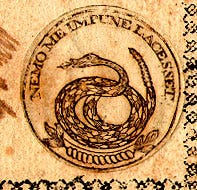
Thinking about the timing of Franklin’s essay above, which was published in the Pennsylvania Journal in December of 1775, he wrote: “I observed on one of the drums belonging to the marines now raising, there was painted a Rattle-Snake, with this modest motto under it, ‘Don't tread on me.’” And Christopher Gadsden did not present his rattlesnake flag to the Provincial Congress until February 1776. Was the Pennsylvania Journal available in Charleston at that time, and would Charles Gadsden have read this letter and been inspired by this description to create his flag a few months later? Or was the rattlesnake “don’t tread on me” image already an “underground” symbol in the Continental military?
While I was unable to find answers to my questions above, Gadsden’s Flag certainly was a tribute to, and an evolution of, Benjamin Franklin’s original “Join, or Die” cartoon.
During the war, Colonel Gadsen had early success in repelling the British Navy’s attack on Charleston in the summer of 1776. This earned him the title of brigadier general.
While Gadsden’s “firebrand” personality was perfect for encouraging and supporting the American Revolution, during the war, his personality would eventually get him into trouble.
In 1777, Gadsden resigned his commission as brigadier general over a disagreement with another general. In 1780, his “irrational temperament cost the United States more than two thousand Continental troops when Charleston fell to the British.”8
After the Revolutionary War, Gadsden tried to rebuild his businesses, which had suffered greatly. He returned to public service briefly in 1788 to vote for the ratification of the United States Constitution and again in 1790 to serve in the state’s constitutional convention.
Gadsden married 3 times, had 4 children, and died on August 28, 1805 after sustaining a head injury during a fall near his home.
Today, his legacy lives on in the iconic flag he designed that continues to be a symbol of early American Independence.
➳ Sources — The History of The Gadsden Flag
"Benjamin Franklin’s ‘Join, or Die’ Cartoon." History, A+E Networks, 12 Apr. 2019, www.history.com/news/ben-franklin-join-or-die-cartoon-french-indian-war. Accessed 31 Jan. 2025.
"Christopher Gadsden." National Park Service, www.nps.gov/people/christopher-gadsden.htm. Accessed 31 Jan. 2025.
"Christopher Gadsden." South Carolina Encyclopedia, The University of South Carolina, www.scencyclopedia.org/sce/entries/gadsden-christopher/. Accessed 31 Jan. 2025.
"Flag of the United States." Hicks, Frederick Cocks, 1918, U.S. Government Printing Office, p. 23. Retrieved 18 Aug. 2016.
Gadsden Flag: 1775: So-Called. The Charleston Museum, www.charlestonmuseum.org/news-events/gadsden-flag-1775-so-called-for-its/. Accessed 31 Jan. 2025.
"Gadsden’s Wharf." Preservation Society of Charleston, www.preservationsociety.org/locations/gadsdens-wharf/. Accessed 31 Jan. 2025.
"Join, or Die: Franklin’s Political Cartoon." Battlefields.org, www.battlefields.org/learn/articles/short-history-united-states-flag. Accessed 31 Jan. 2025.
"Sacred Ground: A Star of Charleston’s New International African American Museum." International African American Museum, iaamuseum.org/news/sacred-ground-a-star-of-charlestons-new-international-african-american-museum/. Accessed 31 Jan. 2025.
"The Story of Gadsden’s Wharf." Charleston Time Machine, Charleston County Public Library, www.ccpl.org/charleston-time-machine/story-gadsdens-wharf. Accessed 31 Jan. 2025.
"Summary of Data for Item 59f5ec4ae4b063d5d307e5cf." ScienceBase Catalog, U.S. Geological Survey, www.sciencebase.gov/catalog/item/59f5ec4ae4b063d5d307e5cf. Accessed 31 Jan. 2025.
I always want to improve my work. Answer the poll below to give me your review of today’s newsletter. I also welcome your suggestions for new content! Simply reply to this email with your ideas. Thank you!
If you voted just “OK” on the newsletter today, I want to hear from you: what would you suggest I improve for next time? Please leave a comment below:
https://www.ccpl.org/charleston-time-machine/story-gadsdens-wharf
https://iaamuseum.org/news/sacred-ground-a-star-of-charlestons-new-international-african-american-museum/
https://www.ccpl.org/charleston-time-machine/remembering-charlestons-liberty-tree-part-1#_edn4
https://www.ccpl.org/charleston-time-machine/remembering-charlestons-liberty-tree-part-1#_edn4
https://www.nps.gov/people/christopher-gadsden.htm
https://www.sciencebase.gov/catalog/item/59f5ec4ae4b063d5d307e5cf
https://greatseal.com/symbols/rattlesnake.html
https://www.scencyclopedia.org/sce/entries/gadsden-christopher/




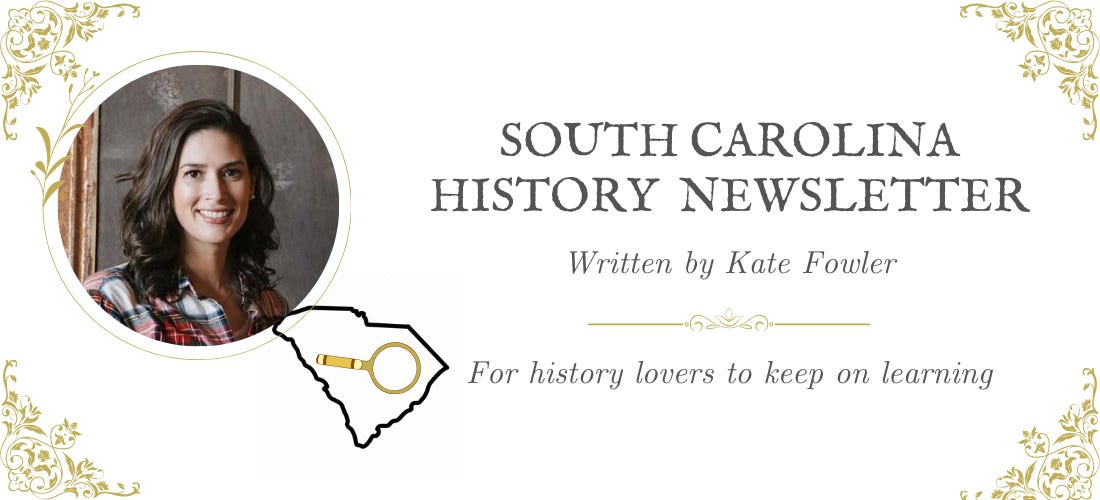



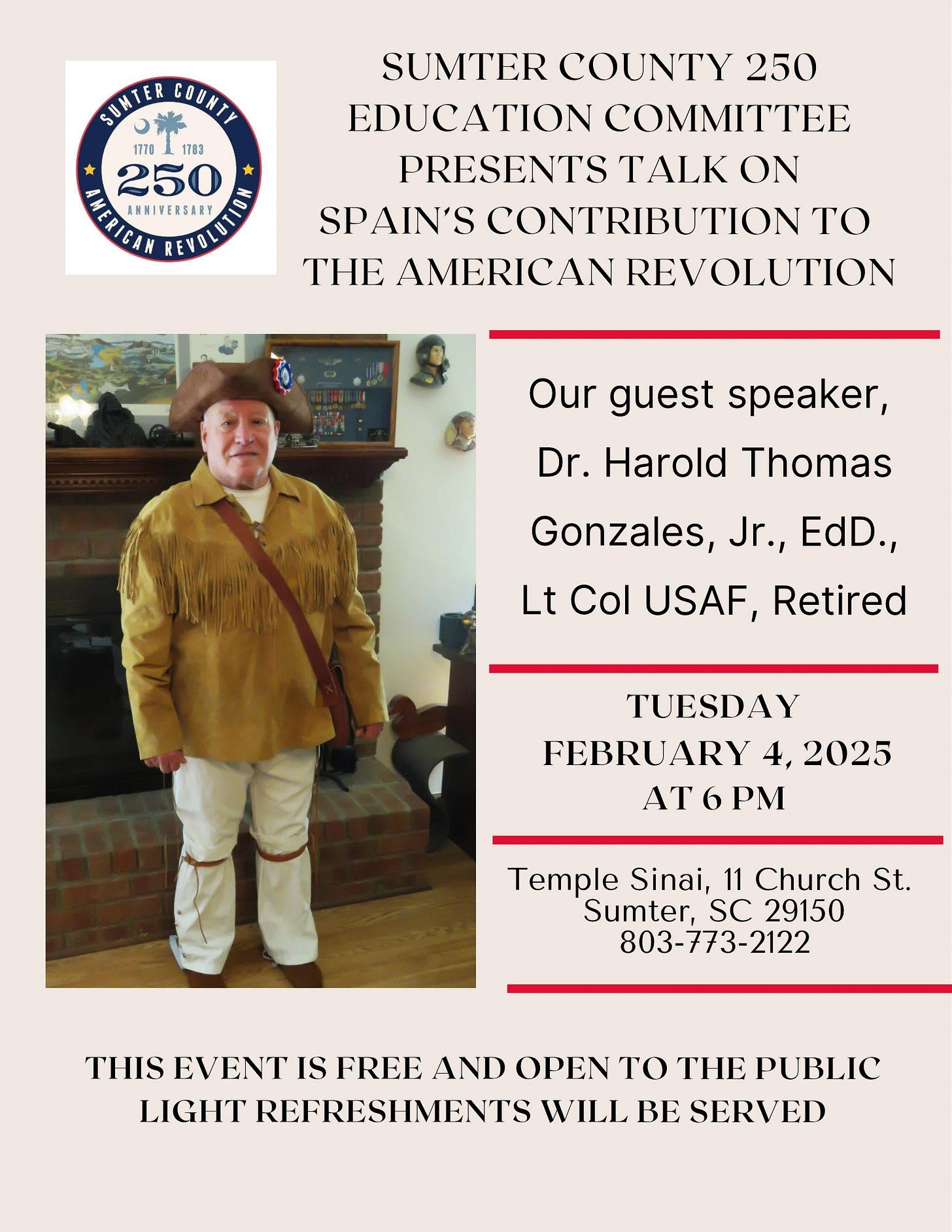






We did the trolley tour and it was fantastic! Highly recommend! We have visited the tea farm twice so far and plan to again next time we come down. The tea is 10/10, all flavors are delicious. The grounds are also like a storybook, so many huge giant live oaks, it’s great half a day trip if you are in the CHS area.